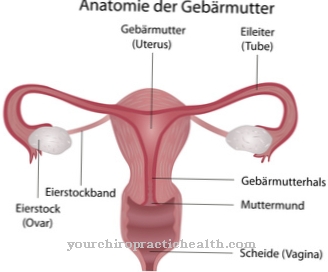The Esophageal atresia is a congenital impairment of the esophagus that usually has to be treated surgically. The therapeutic results are often good.
What is esophageal atresia?
In the Esophageal atresia it is a malformation of the esophagus. Esophageal atresia is characterized, among other things, by a severely narrowed or completely missing connection between the esophagus and stomach.
As a result, food ingested by the person affected cannot naturally reach the stomach. The already congenital esophageal atresia can take different forms depending on the patient; in the vast majority of those affected (in approx. 85% of cases) the esophageal atresia is associated with a connection (fistula) between the esophagus and trachea that does not correspond to the healthy anatomy.
In medicine, such a case is called esophageal atresia with tracheo-esophageal fistula. This tracheo-oesophageal fistula can cause problems that saliva or gastric juice get into the airways or that air from the airways leads to a distension of the stomach.
Different forms of esophageal atresia occur on average in approximately 1 in 3,000 newborns. Boys show the developmental disorder slightly more often than girls.
causes
The causes of a Esophageal atresia are still largely unknown to medicine.
It is assumed, however, that esophageal atresia begins to develop in the fetus during the first few weeks of pregnancy. The developmental disorder leads to the fact that the separation between esophagus and trachea in the affected fetus is limited.
This assumption is supported, among other things, by the high number of patients who, in addition to the esophageal atresia, also have a fistula between the esophagus and trachea.
Symptoms, ailments & signs
All forms of esophageal atresia cause severe discomfort to affected newborns and, if left untreated, lead to death. Newborn infants suffering from esophageal atresia are initially noticed by increased salivation. Furthermore, the baby suffers from extreme shortness of breath and a strong cough.
The esophagus and windpipe are connected by fistula formation. As a result, food residues always get into the windpipe when the children are fed. The skin and mucous membranes turn blue (cyanosis) because the body can no longer be supplied with sufficient oxygen. Artificial feeding through a gastric tube is not possible.
It fails because of resistance because the connection between the esophagus and stomach is either missing or insufficiently developed. Certain forms of esophageal atresia often lead to so-called aspiration pneumonia, which manifests itself in increased secretion and spasms of the bronchial muscles with increased dyspnoea and even cyanosis.
Since the condition of an esophageal atresia is life-threatening for the infant, the constrictions and fistulas must urgently be surgically removed. Surgical treatment can ensure the child's survival by up to 90 percent. However, the success of the treatment also depends on possible other organic malformations, which in addition to the esophagus can also affect the gastrointestinal tract, the heart, the kidneys, the spine or the extremities.
Diagnosis & course
Suspicion of a present Esophageal atresia must in many cases already be provided as part of a prenatal diagnosis (examinations on the fetus in the womb).
In particular, recordings using ultrasound are used for this purpose. In this context, an increased amount of amniotic fluid (also known as polyhydramnios in medicine) in the expectant mother can indicate esophageal atresia.
However, the final diagnostic confirmation of esophageal atresia can usually only be made on the basis of an examination of the newborn with the help of a gastric tube and / or X-rays. Symptoms that could indicate esophageal atresia in a newborn include increased amounts of frothy saliva and severe coughing during attempts to feed.
Successfully treated esophageal atresia in the newborn usually requires several years of follow-up treatment. Possible complications after treatment include, for example, relaxation of the trachea or renewed narrowing in the treated area of the esophagus. Esophageal atresia can be treated successfully in most cases, especially in infants with a birth weight of over 1500 g and an intact heart.
Complications
If the esophagus is so badly deformed that food can no longer naturally reach the digestive tract or if the connection between the esophagus and stomach is completely absent, this disorder is fatal for the person affected if left untreated. Usually the malformation can be corrected surgically.
If the esophageal atresia is very pronounced, the procedure is necessary in childhood. Complications from this operation are more common in children than in adults. On the one hand, a shrinkage of the seam is to be expected, which can result in a stricture and a consequent hindrance in eating.
If scarring of the esophagus occurs as a result of the operation, this can have a similar effect. There is also a risk of suture insufficiency, which is especially the case if a larger defect has to be corrected. In this case, the risk of fistulas forming, which in the worst case can even affect the lungs, increases.
In addition, there is another risk that is specific to children. Following the surgical correction of the esophageal atresia, follow-up interventions are often necessary because the children have swallowed foreign bodies and these block the esophagus more frequently than usual.
When should you go to the doctor?
Esophageal atresia is a congenital disorder of the esophagus. Therefore, the first disturbances and abnormalities appear immediately after birth. If there are irregularities in the intake of food or if there are disturbances in breathing, the newborn needs medical care as quickly as possible. If the skin turns blue, looks pale or if breathing is impaired, action must be taken as soon as possible. A weakness or restrictions in the movements of the infant should be understood as a warning signal. If there is difficulty in breathing, first aid measures must be taken by those present, as otherwise there is a risk of premature death.
In most cases, the delivery takes place in the presence of obstetricians or medically trained personnel. Therefore, the first irregularities are noticed by the care team and the necessary steps are automatically initiated. If an abnormality is noticed while feeding the infant, irregular swallowing or increased saliva formation, action is required. Since this disease can lead to premature death, professional action must always be taken quickly and immediately. If there is a cough or if ingested food elements are immediately vomited, the infant needs medical help. Special features of the heart rhythm, visual abnormalities of the body as well as malformations must be examined and treated more closely.
Treatment & Therapy
The Esophageal atresia usually requires surgical intervention on the affected infant as early as possible.In the run-up to a corresponding operation, the upper body of a sick child is usually elevated. With the help of a probe, saliva and other secretions that cannot be swallowed due to the esophageal atresia are then constantly sucked out.
Which surgical methods are used to treat esophageal atresia in each individual case depends primarily on the form and severity of the malformation. If the connection between the upper and lower parts of the esophagus is only missing over a comparatively short distance, for example, this defect can often be repaired as part of a one-off operation.
If the esophageal atresia requires a connection of the esophageal parts over longer distances, it is possible, for example, to initially lengthen the esophagus over a certain period of time or to replace missing parts with tissue from the intestine or stomach. Existing fistulas to the airways must be closed so that breathing is not endangered by penetrating foreign bodies.
prevention
Since the exact causes of a Esophageal atresia are unknown, the developmental disorder can hardly be prevented. Regular prenatal check-ups can, however, help to detect signs of esophageal atresia at an early stage. In this way, necessary medical measures can be taken quickly after the birth of an affected child.
You can do that yourself
If esophageal atresia is present, a hospital or specialist clinic should be visited promptly. In acute cases, the emergency doctor must be alerted, as an emergency operation may have to be initiated immediately. After an operation, the sick child has to take it easy. Moderate exercise is possible in consultation with the pediatrician, whereby the state of health is decisive.
In addition, parents should adhere to the doctor's instructions regarding wound care. If complications arise, it is best to inform the doctor immediately. Side effects and interactions should also be discussed with a specialist.
It is also important to determine the cause of the esophageal atresia and to work with the doctor to ensure that there is no new medical emergency. The syndrome is usually congenital, which is why the usual newborn screenings are sufficient as a diagnostic method. The parents of the affected child should still watch out for any unusual symptoms and, if in doubt, inform the doctor.
In addition, it can be useful to deal with the stress associated with the suffering as part of a therapy. This is particularly necessary if the disease is severe.


.jpg)


.jpg)







.jpg)

.jpg)
.jpg)











.jpg)